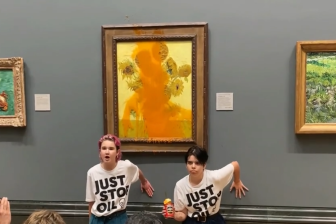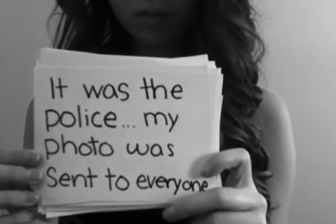The gasps in room 43 of the National Gallery in London capture the raw emotion of a shocking moment.
On Friday, two activists with the group Just Stop Oil walked into the gallery and tossed a can of tomato soup on a priceless painting by the Dutch painter Vincent van Gogh. It’s one of the most important pieces in the museum, worth incalculable millions.
That protest action was met with a shout of, “Oh my gosh,” and calls for museum security to respond to the brazen and unlawful act.
“Are you more concerned about the protection of a painting or the protection of our planet and people?” shouted one of the activists, Phoebe Plummer, 21, upon throwing the soup at the painting. Joining her in the protest was another young activist, 20-year-old Anna Holland. Both were arrested by London police.
There was no damage to the painting because it was covered by glass, something the protesters say they took into account ahead of time. Still, their disruptive action, which has gone viral on social media, is raising questions about the extent to which climate action is considered ‘fair play.’
“We’re not doing this to be popular,” insists Grahame Buss, a spokesperson with Just Stop Oil. “It’s about bringing change.”
Except that it could backfire.
Read more:
Climate protesters douse Vincent van Gogh’s ‘Sunflowers’ with tomato soup
Read More
Edward Maibach, an authority on how people engage with the climate emergency, said research shows “many people support non-violent civil disobedience in defense of our climate.”
But, he suspects that people willing to engage in such action “would not understand or support the actions of protesters who damage property that is completely unrelated to fossil fuel production or transportation — such as a priceless Van [Gogh] painting.”
In fact, many comments on social media spoke to the seemingly inchoate strategy of targeting a painter who lived his life in poverty in order to make a point about social inequality.
“Indeed,” Maibach added in an email to Global News, “I suspect that tactics such as this will only serve to alienate many highly climate-concerned people, and will therefore be counter-productive.”
Targeting art
The vandalism directed at the Van Gogh ‘Sunflowers’ masterpiece is the latest in a series of attacks against works of art, the latest target for the most disruptive form of climate action. Such action has included everything from blocking traffic to damaging the pumps at gas stations.
Now it’s art.
In July, protesters in Italy glued themselves to a painting by Sandro Botticelli at a museum in Florence. They’ve done the same to a work by Picasso in Australia.
Just Stop Oil, the group behind Friday’s attack in London, calls this form of protest “art action.”
“We feel we have no choice, no choice but to take these actions,” Buss, who worked for energy giant Shell for 33 years, told Global News. He calls the attack against the painting an act of desperation but also “an act of love.”
“It’s no longer a future issue,” he added, referring to the climate crisis. “It’s no longer something that’s going to happen at the end of the century.”
That need for disruptive action is also espoused by Swedish author Andreas Malm whose provocative book How to blow up a pipeline made more than a few ripples both within the climate movement and outside of it.
In an interview with the media outlet Vox last October, Malm says he isn’t sure if non-violent action, which he defines as that which does not harm humans, will work to force politicians to take action to mitigate the climate crisis.
“But I think that the situation is so dire, so extreme, that we have to experiment, we have to try,” he said. “What we tried so far has only taken us so far. It’s given us limited success, but we still haven’t managed to dent the curves and bring emissions down and start the transition.”
A cry for help
Just Stop Oil insists it wants to pressure the British government to immediately halt its plans for opening up a new round of licensing for drilling oil in the North Sea, something climate activists see as incompatible with a habitable planet Earth.
“We’re not saying stop all oil and gas production now,” insists Buss. “What we’re saying is we stop new projects.”
In the soup-throwing video, however, Plummer, one of the activists, says, “Fuel is unaffordable to millions of cold, hungry families. They can’t even afford to heat a tin of soup.”
Much of that fuel, at least for now, is still going to come in the form of oil and gas, especially in the wake of Russia’s attack on Ukraine.
The war has heightened energy security fears across Europe this winter, and countries like Germany are resorting to the dirtiest of fossil fuels — coal — as a temporary relief measure. Even China, a world leader in renewable energy, is doubling down on coal, a worrisome prospect for the planet.
“I understand why somebody would get offended by desecrating a masterpiece,” says Tara Mahoney, a Vancouver-based advocate who has years of experience crafting social movements to engage ordinary people on the climate crisis.
School children study Vincent van Gogh’s Sunflowers painting at the “EY Exhibition: Van Gogh and Britain” on March 25, 2019 in London, United Kingdom.
Stuart C. Wilson/Getty Images
But, she says, at its heart, the calculus driving these young activists is fear — and that that is understandable.
“Put yourself in their shoes. You’re at the beginning of your life, and you’re terrified of what the future can hold,” she says.
There is desperation, Mahoney says. “Nothing seems to be working. The decision-makers are not responding in the way that seems like you would if the future of a liveable planet was at risk.”
That, and the fact, she says, that climate change was caused by big companies who willfully ignored science and got the world to this point.
It wasn’t as if “one day we woke up and oh the climate crisis is a problem.”
“There are companies that chose to get us here,” she says.
As for the desecration of a priceless work of art, Mahoney says, there are other priceless treasures that are also at risk, but that the world thinks less often about.
“You want to talk about ruining masterpieces […] what about the masterpiece that is the coral reef off the coast of Australia or the old growth forests on Vancouver Island?” Mahoney says.
“These are timeless masterpieces that once they’re gone, they’re gone.”




